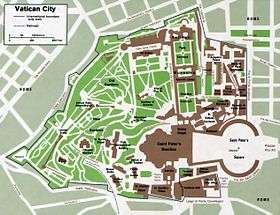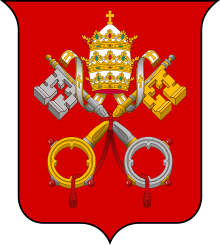Transport in Vatican City

The transportation system in Vatican City, a country 1.05 km long and 0.85 km wide,[1] is a small transportation system with no airports or highways. There is no public transport in the country. A heliport and a short railway is used for special occasions only. Most visitors will walk from a nearby Italian bus or train stop, or car parking. Given an average walking speed of 3.6 km/h,[2] Vatican City can be crossed in 20 minutes or less. Thus, much of the infrastructure in the Vatican consists of St. Peter's Square itself, hallways and aisles in the basilica and surrounding buildings, and walkways behind and between the buildings.[1] The Vatican City Heliport is in the western corner of the city-state, and is used only for officials of the Holy See and official visitors.[3]
Air transport

Vatican City is served by Vatican City Heliport, sometimes used by official visitors. There is no public airport and visitors may use the two airports of Rome: Ciampino and Fiumicino.
Railway
There is a short, 852 meter, standard gauge (4.7 ft.) railway that connects to surrounding Italy's network at the Saint Peter's station in the capital of Rome. Vatican City railway station was designed by architect Giuseppe Momo and was constructed during the reign of Pope Pius XI after the conclusion of the Lateran Treaties, opening in 1933. The railway was originally planned to transport pilgrims, but in the event has rarely transported passengers. Pope John XXIII was the first to travel on it, and Pope John Paul II was known to have used it, but rarely. The railway is mainly used to transport freight.
Rome Metro line A passes the Vatican at Ottaviano and Cipro-Musei Vaticani metro stations. Both stops are a ten-minute walk away from the city-state.[4]
Road vehicles
Vehicle registration plates of official road vehicles registered in Vatican City use the prefix SCV (standing for State of the City of Vatican) followed by a series of digits, while vehicle registration plates of residential road vehicles registered in Vatican City use the prefix CV followed by a series of digits. The international identification plate/sticker is V. The Pope's car has usually carried the registration SCV 1 in red lettering. As there is more than one vehicle used to transport the Pope, multiple registered vehicles in Vatican City use the SCV 1 registration plate.
Vehicle fleet
Pope Francis, who called for a more frugal lifestyle for the Catholic clergy in general,[5] downgraded the Papal vehicles (reminiscent of his preference for public transport as Archbishop).[6] He drives himself inside the Vatican in a small, 1984 Renault 4,[7] and has ditched the bulletproof Popemobile.[8][9]
See also
References
- 1 2 Documentation
- ↑ Walking speed
- ↑ Vatican City Archived 2005-12-22 at the Wayback Machine. Tiscali retrieved November 27, 2006
- ↑ Vatican City State Railway Railways of the World retrieved August 8, 2006
- ↑ "Frugal Pope Francis says no flashy car for me as he turns to second hand Fiat during visit". Telegraph.co.uk. Retrieved 2017-06-19.
- ↑ "Quiet thunder in Argentina | CatholicHerald.co.uk". CatholicHerald.co.uk. 2013-03-13. Retrieved 2017-06-19.
- ↑ "Pope Francis to drive his own 'popemobile' inside Vatican City". Reuters. September 12, 2013. Retrieved 2017-06-19.
- ↑ CNN, By Laura Smith-Spark. "Pope Francis ditches bulletproof Popemobile - CNN.com". CNN. Retrieved 2017-06-19.
- ↑ "Pope Francis shuns bullet-proof vehicle for visit to Cairo despite recent terrorist attacks". The Telegraph. Retrieved 2017-06-19.
External links

.jpg)
